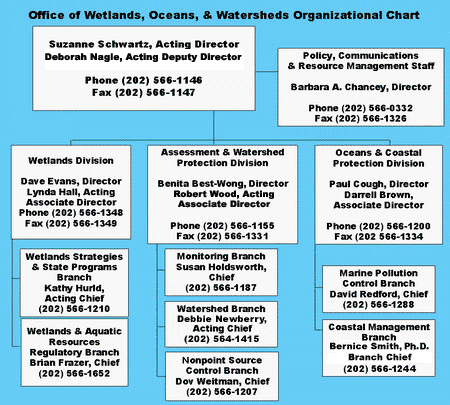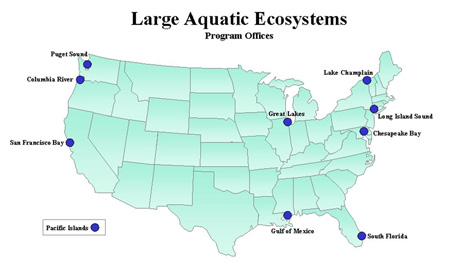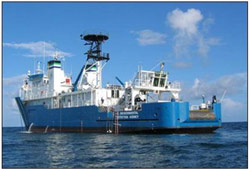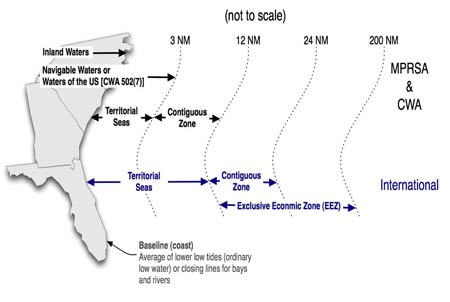Water: Oceans, Coasts, Estuaries & Beaches
The Oceans and Coastal Protection Division Frequently Asked Questions
- Who are we?
- How are we organized?
- What are OCPD's priority programs?
- What Statutory Authorities do we operate under?
- What Geographic Area do we focus on?
- How do we measure our performance?
- Key OCPD Reports and Publications
- How to contact us?
- OCPD Web links
Who are we?
The mission of the Oceans and Coastal Protection Division (OCPD) is to protect and restore our ocean and coastal ecosystems by promoting watershed-based coastal management, preventing pollution of the marine environment, monitoring and assessing coastal conditions, and establishing effective partnerships. The vision for OCPD is of clean and safe oceans and coasts that sustain human health, the environment, and the economy.
The Coastal Management Branch (CMB) and the Marine Pollution Control Branch (MPCB) are the two primary operating units of the Division. CMB is responsible for the management of OCPD's voluntary programs, such as the National Estuary Program, Climate Ready Estuaries, Gulf of Mexico hypoxia, the National Coastal Condition Reports, and the Large Aquatic Ecosystems Council. MPCB is responsible for the management of several national regulatory programs, including ocean dumping and dredging, discharges from land to ocean waters, vessel and cruise ship discharges, as well as non-regulatory programs including the Marine Debris Prevention Program and management of EPA's OSV Bold. The Immediate Office (IO) manages cross-cutting partnerships such as the Subcommittee on Integrated Management of Ocean Resources, the Howard University-EPA Memorandum of Understanding, Coastal America, and the U.S. Coral Reef Task Force.
How are we organized?
OCPD is located within the Office of Wetlands, Oceans, and Watersheds, under the Office of Water.

What are OCPD's priority programs?
Coastal Watershed Protection
Large Aquatic Ecosystems Council
The Council of Large Aquatic Ecosystems is charted to support and promote EPA's implementation of Large Aquatic Ecosystem programs and encourage collaboration within EPA programs and with our external partners, especially states, to help protect and restore large aquatic ecosystems. The Council has five key objectives: (1) Strengthen Aquatic Ecosystem Programs; (2) Strengthen Core Water Program Implementation; (3) Improve Aquatic Ecosystem Program Links to EPA Strategic Plan and Budget; (4) Improve Aquatic Ecosystem Program Links to EPA Research Plans; and (5) Develop and Define New Aquatic Ecosystem Programs.

Climate Ready Estuaries
The Climate Ready Estuaries program is a partnership between EPA and the National Estuary Programs (NEPs) to address climate change in coastal areas. This effort is building additional capacity in coastal communities as they prepare to adapt to the effects of climate change.
Climate Ready Estuaries is supporting NEPs and coastal communities in becoming "climate ready" by providing tools and assistance to:
- Assess climate change vulnerabilities
- Develop and implement adaptation strategies
- Engage and educate stakeholders
- Share lessons learned with other coastal managers
National Estuary Program
Established in 1987 under the Clean Water Act Amendments, the National Estuary Program (NEP) is a successful community-based program designed to restore and maintain the water quality and ecological integrity of estuaries of national significance. The NEP uses an effective watershed-based ecosystem planning approach to connect upstream pollution sources with downstream impacts.
A unique voluntary program, it operates through partnerships among Federal, State, and local agencies; nonprofit organizations; industry; academia; environmental and business groups; and community residents. There are 28 NEPs across the country, each led by a director and staff who work in concert with these key stakeholders. The EPA provides technical and financial assistance, and management guidance to these partnerships. Each NEP works using an inclusive collaborative decision-making process to deliver on-the-ground action making the NEP an important model for protection and management of coastal and non-coastal watersheds.

Marine Pollution Prevention
Vessel discharges
Significant environmental impacts to coastal and ocean ecosystems can occur via direct pollution from vessels, and as a vector for the invasion of non-indigenous species. Pollution from vessels emanates from a variety of sources, and include: gray water, bilgewater, blackwater (sewage), ballast water, anti-fouling paints (and their leachate), hazardous materials, and garbage and other wastes. EPA regulates vessel discharges through:
Vessel Discharge Permit Program
The 2008 Vessel General Permit (VGP) regulates discharges incidental to the normal operation of vessels operating in a capacity as a means of transportation. The VGP includes general effluent limits applicable to all discharges; general effluent limits applicable to 26 specific discharge streams; narrative water-quality based effluent limits; inspection, monitoring, recordkeeping, and reporting requirements; and additional requirements applicable to certain vessel types.
Clean Boating Act
The Clean Boating Act of 2008 (Public Law 110-288, 122 Stat. 2650-2653) amends the Federal Water Pollution Control Act (commonly known as the Clean Water Act) to provide that no permit shall be required by the Administrator of the Environmental Protection Agency (Administrator) under the national pollutant discharge elimination system for the discharge from a recreational vessel of graywater, bilge water, cooling water, weather deck runoff, oil water separator effluent, or effluent from properly functioning marine engines or for any other discharge that is incidental to the normal operation of such vessel.
Invasive Species and Ballast Water
The U.S. Coast Guard, the primary federal agency charged with establishing controls on ballast water discharges, is working closely with EPA and other federal agencies to improve ballast water management by ships and to reduce the potential for introduction of invasive species by ships. Individual states affected by invasive species from ballast water are also working to address the issue for their waters.
Cruise Ship Water Discharges
EPA is assessing the need for additional standards for sewage and graywater discharges from large cruise ships operating in Alaska. With ever-larger cruise ships and the increasing popularity of cruises, it is essential that we know whether current standards are adequately protecting human health and the environment.
Vessel Sewage Discharges and No Discharge Zones
Under Section 312 of CWA, EPA or States may establish no-discharge zones in which the discharge of sewage from all vessels into specified waters is prohibited. Under CWA Section 312(f)(3), a State may designate portions of their waters as no-discharge zones if the State determines that the protection and enhancement of the quality of the waters require greater environmental protection than current Federal standards allow. In this instance, EPA is required to determine if there are adequate pumpout facilities available. Additionally, a State may make a written application to the Administrator under CWA Sections 312 (f)(4)(A) or 312 (f)(4)(B), for the issuance of a regulation completely prohibiting discharge from a vessel of any sewage, whether treated or not, into specified waters that have environmental importance or waters that serve as drinking water intakes, respectively. The application requirements may vary depending on whether it's an application under CWA Sections 312(f)(3), 312(f)(4)(a), or 312 (f)(4)(B).
Ocean dumping/dredging
In 1972, Congress enacted the Marine Protection, Research, and Sanctuaries Act (MPRSA, also known as the Ocean Dumping Act) to prohibit the dumping of material into the ocean that would unreasonably degrade or endanger human health or the marine environment. Virtually all material ocean dumped today is dredged material (sediments) removed from the bottom of waterbodies in order to maintain navigation channels and berthing areas. Other materials that are currently ocean dumped include fish wastes, human remains, and vessels.
Ocean dumping requires a permit issued under the MPRSA. In the case of dredged material, the decision to issue a permit is made by the U.S. Army Corps of Engineers, using EPA´s environmental criteria and subject to EPA´s concurrence. For all other materials, EPA is the permitting agency. EPA also is responsible for designating recommended ocean dumping sites.
Hypoxia
The Mississippi River/Gulf of Mexico Watershed Nutrient Task Force was established in the fall of 1997 to understand the causes and effects of eutrophication in the Gulf of Mexico; coordinate activities to reduce the size, severity, and duration; and ameliorate the effects of hypoxia. Activities include coordinating and supporting nutrient management activities from all sources, restoring habitats to trap and assimilate nutrients, and supporting other hypoxia related activities in the Mississippi River and Gulf of Mexico watersheds.
Marine debris
EPA uses a comprehensive watershed approach to address the issue of marine debris. Marine debris is an environmental problem that stretches beyond the set responsibilities of any individual EPA office. As a result, EPA through pollution prevention, recycling, waste treatment and control programs, and partnerships addresses the various stressors that lead to marine debris. In addition, EPA uses existing regulatory authorities and mandates to address the sources, movement, and impacts of marine debris.
Monitoring and Assessment

The OSV Bold supports EPA's efforts to monitor and assess impacts on ocean and coastal waters from land- and ocean-based human activities and naturally occurring ecological disturbances.
National Coastal Condition Reports
The National Coastal Condition Report (NCCR) describes the ecological health of U.S. coastal waters and the Great Lakes at a regional and national scale. First issued in 2001, and updated periodically thereafter, the NCCR is a collaborative effort among EPA and other federal agencies, as well as state, regional, and local organizations. It is one of only a few statistically-significant measures of U.S. water quality on a nationwide basis. The 2004 NCCR was produced using data from EMAP. The third National Coastal Condition Report, released in 2008, assesses condition of the nation's coastal waters, including Alaska and Hawaii, based primarily on coastal monitoring data from EPA's National Coastal Assessment collected in 2001 and 2002. The condition of the nation's coastal waters continues to be fair. An analysis of temporal changes in estuarine condition from 1990 to 2002 is presented for the nation's coastal waters and by region.
Partnerships - Who are Our Partners?
Strengthen ocean/coastal partnerships
EPA works with national and international agencies and groups to protect the ocean and coastal environments. Many of these groups - federal, state, and nongovernmental organizations - play an important role in the implementation of our regulatory and voluntary programs. Below is a list that identifies a number of our nonfederal partners on local, regional, and national scales.
Non Federal Partners
- American Association of Port Authorities
- American Chemistry Council (ACC)
- American Society for Testing and Materials
- American Waterways Operators
- Anacostia Watershed Society
- Artificial Reefs of the Keys
- ASIWPCA
- Association of National Estuary Programs
- Atlantic States/Gulf States Marine Fisheries Commission (Artificial Reefs Subcommittee)
- Basel Action Network (BAN)
- Blue Water Network, now part of Friends of the Earth
- Boat US
- Chamber of Shipping of America
- Clean Ocean Action
- Coastal America
- Coastal and Estuarine Research Federation
- Coastal States Organization
- Cruise Lines International Association (CLIA)
- Dredging Council of America
- Environmental Defense
- Environmental Finance Center Network / Advisory Board, Interagency Committee on Ocean and Science Resource Management Integration
- Environmental Law Institute
- Greenpeace International
- Institute for Conservation Leadership
- Islands Tourism Association
- Marine Transportation System
- Mississippi River Basin and Gulf of Mexico Hypoxia
- National Association of Counties
- National Association of Marine Manufacturers
- National Clean boating Association
- National Dredging Team
- National Marine Sanctuary Foundation, American Chemistry Council (ACC)
- National Ocean Economics Project
- National Wildlife Federation
- Natural Resources Defense Council
- North West Cruiseship Association (NWCA)
- Northwest Environmental Advocates
- Oceana
- Pacific Environmental Advocacy Center
- Plastics Division
- Reefmakers
- Restore America's Estuaries
- River Network
- Sheavly Consultants Inc
- Smart Growth America
- Subcommittee on the Integrated Management of Ocean Resources
- The Coastal Society
- The Nature Conservancy
- The Ocean Conservancy
- US Coral Reef Task Force
- US Green Building Council
- Western Dredging Association (WEDA)
What Statutory Authorities do we operate under?
- Clean Water Act (CWA)
-
- the management of the National Estuary (CWA, section 320)
- 312(o) / 301(h) / 403 (c): the authority for regulating discharges from recreational vessels
- Marine Protection Research and Sanctuaries Act (MPRSA)
-
- the control of dumping of dredged material (and other materials) into ocean waters under section 103 of MPRSA
- Ocean Dumping Ban Act
-
- Shore Protection Act
- Marine Plastic Pollution Research and Control Act
- Title XIV: "Certain Alaskan Cruise Ship Operations"
What Geographic Area do we focus on?
(e.g., coastal: NEP and LAE areas, coastal HUC8)

How do we measure our performance?
Improve Coastal and Ocean Waters - Measure #: Subobjective 2.2.2
Prevent water pollution and protect coastal and ocean systems to improve national and regional coastal aquatic system health by at least 0.2 points on the "good/fair/poor" scale of the National Coastal Condition Report.
Improve Coastal and Ocean Waters - Measure #: Strategic Targets (SP-16 to SP-19)
Maintain aquatic ecosystem health on the "good/fair/poor" scale of the National Coastal Condition Report in the following Regions: Northeast; West Coast; Southeast; and Puerto Rico.
Improve Coastal and Ocean Waters - Measure #: Strategic Target SP-20
Percent of dredged material ocean dumping sites that will have achieved environmentally acceptable conditions (as reflected in each site's management plan and measured through on-site monitoring programs).
Improve Coastal and Ocean Waters - Measure #: Subobjective 4.3.2
Working with partners, protect or restore additional acres of habitat within the study areas for the 28 estuaries that are part of the National Estuary Program.
Improve Coastal and Ocean Waters - Measure #: CO-2
Total coastal and non-coastal square miles protected from vessel sewage by "no discharge zone(s)." (cumulative)
Improve Coastal and Ocean Waters - Measure #: CO-3
Number of National Estuary Program priority actions in Comprehensive Conservation and Management Plans that have been completed. (cumulative)
Improve Coastal and Ocean Waters - Measure #: CO-4
Rate of return on Federal investment for the National Estuary Programs [dollar value of "primary" leveraged resources (cash or in-kind) divided by Section 320 funds].
Improve Coastal and Ocean Waters - Measure #: CO-5
Number of dredged material management plans that are in place for major ports and harbors.
Improve Coastal and Ocean Waters - Measure #: CO-6
Number of active dredged material ocean dumping sites that are monitored in the reporting year.
LAE-specific Measures
Restore and Protect the Columbia River Basin - Measure #: Strategic Target SP-52
Protect, enhance, or restore acres of wetland habitat and acres of upland habitat in the Lower Columbia River watershed.
Restore and Protect the Columbia River Basin - Measure #: Strategic Target SP-53
Clean up acres of known contaminated sediments.
Restore and Protect the Columbia River Basin - Measure #: Strategic Target SP-54
Demonstrate a reduction in mean concentration of contaminants of concern found in water and fish tissue.
Restore and Protect Long Island Sound - Measure #: Strategic Target SP-41
Reduce point source nitrogen discharges to Long Island Sound as measured by the Long Island Sound Nitrogen Total Maximum Daily Load (TMDL).
Restore and Protect Long Island Sound - Measure #: Strategic Target SP-42
Reduce the size of the hypoxic area in Long Island Sound (i.e., defined as the area in which the long-term average maximum July-September dissolved oxygen level is <3mg/lb; reduce the average duration of the maximum hypoxic event.
Restore and Protect Long Island Sound - Measure #: Strategic Target SP-43
Restore or protect acres of coastal habitat, including tidal wetlands, dunes, riparian buffers, and freshwater wetlands.
Restore and Protect Long Island Sound - Measure #: Strategic Target SP-44
Re-open miles of river and stream corridor to anadromous fish passage through removal of dams and barriers or installations of by-pass structures such as fishways.
Restore and Protect the Puget Sound Basin - Measure #: Strategic Target SP-49
Improve water quality and enable the lifting of harvest restrictions in acres of shellfish bed growing areas impacted by degraded or declining water quality.
Restore and Protect the Puget Sound Basin - Measure #: Strategic Target SP-50
Remediate acres of prioritized contaminated sediments.
Restore and Protect the Puget Sound Basin - Measure #: Strategic Target SP-51
Restore acres of tidally-and seasonally-influenced estuarine wetlands.
Restore and Protect the South Florida Ecosystem - Measure #: Strategic Target SP-45
Achieve "no net loss" of stony coral cover (mean percent stony coral cover) in the Florida Keys National Marine Sanctuary and in the coastal waters of Dade, Broward, and Palm Beach Counties, Florida, working with all stakeholders (federal, state, regional, and local).
Restore and Protect the South Florida Ecosystem - Measure #: Strategic Target SP-46
Annually maintain the overall health and functionality of sea grass beds in the FKNMS as measured by the long-term sea grass monitoring project that addresses composition and abundance, productivity, and nutrient availability.
Restore and Protect the South Florida Ecosystem - Measure #: Strategic Target SP-47
Annually maintain the overall water quality of the near shore and coastal waters of the Florida Keys National Marine Sanctuary.
Restore and Protect the South Florida Ecosystem - Measure #: Strategic Target SP-48
Improve the water quality of the Everglades ecosystem as measured by total phosphorus, including meeting the 10 parts per billion (ppb) total phosphorus criterion throughout the Everglades Protection Area marsh and the effluent limits to be established for discharges from Stormwater Treatment Areas.
Sustain and Restore Pacific Island Territories -
Measure #: Strategic Target SP-26 National Office Lead: Region 9
Measure Description: Percent of the population in each of the U.S. Pacific Island Territories served by community drinking water systems that receive continuous drinking water that meets all applicable health-based drinking water standards throughout the year.
Sustain and Restore Pacific Island Territories - Measure #: Strategic Target SP-27
Percent of the time that the sewage treatment plants in the U.S. Pacific Island Territories comply with permit limits for biochemical oxygen demand (BOD) and total suspended solids (TSS).
Sustain and Restore Pacific Island Territories - Measure #: Strategic Target SP-28
Percent of days of the beach season that beaches in each of the U.S. Pacific Island Territories monitored under the Beach Safety Program will be open and safe for swimming.
Key OCPD Reports and Publications
Link to Publications
How to contact us?
Phone: (202) 566-1200
FAX: (202)566-1334
